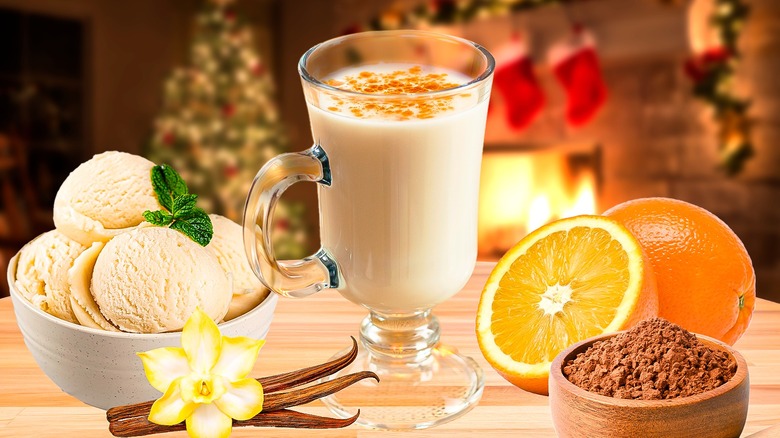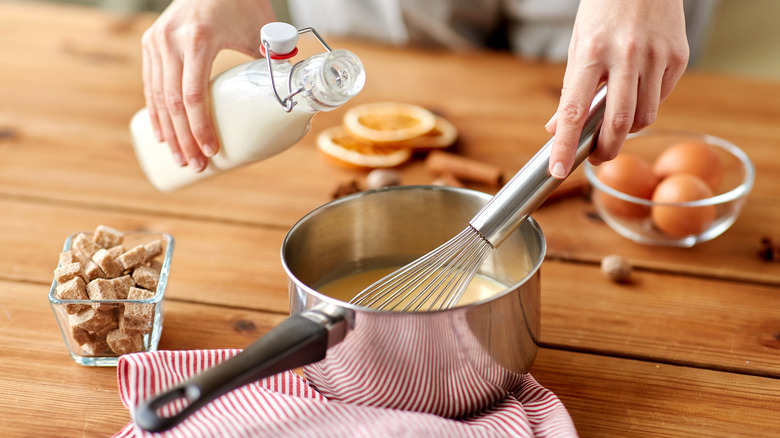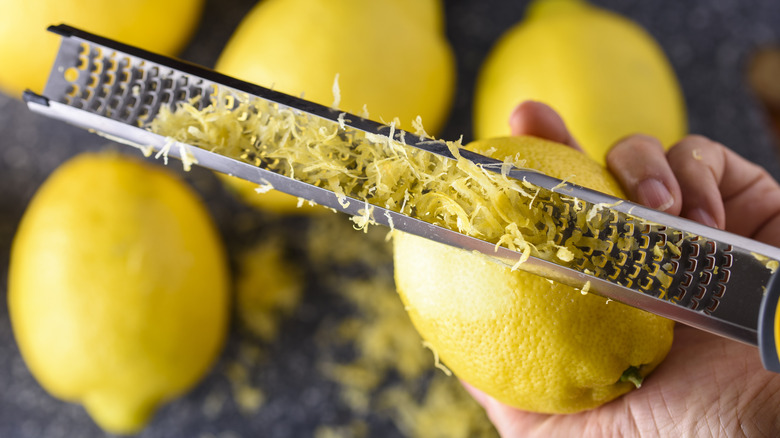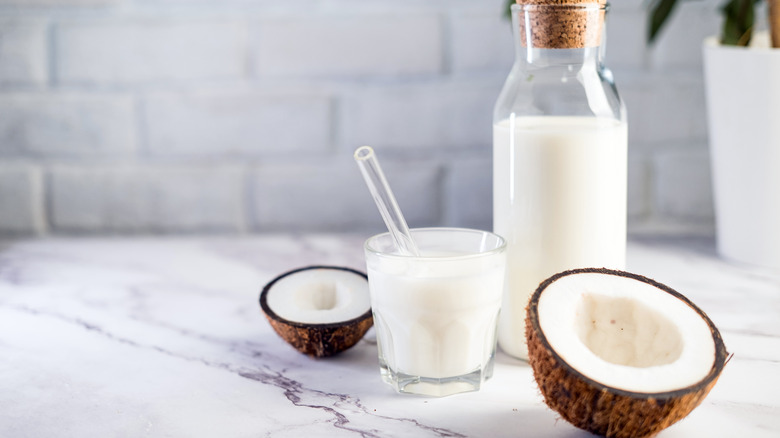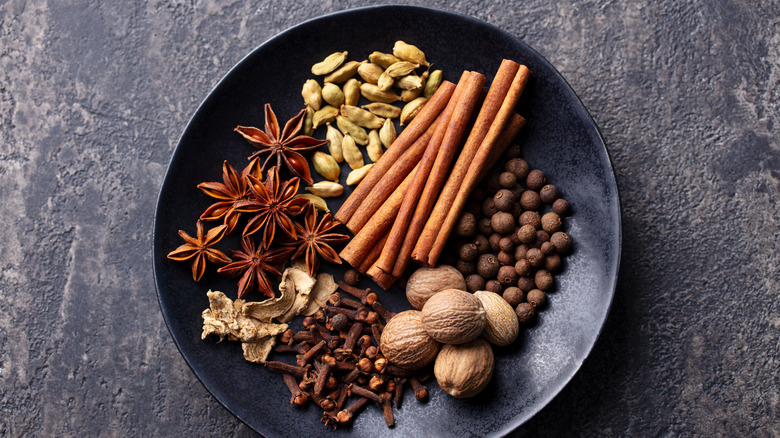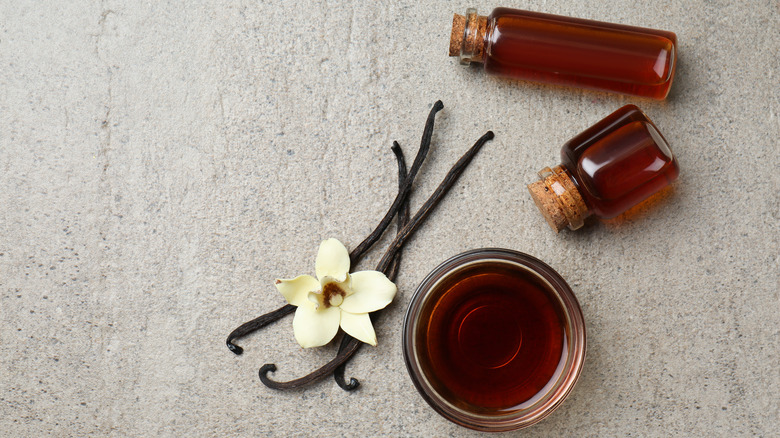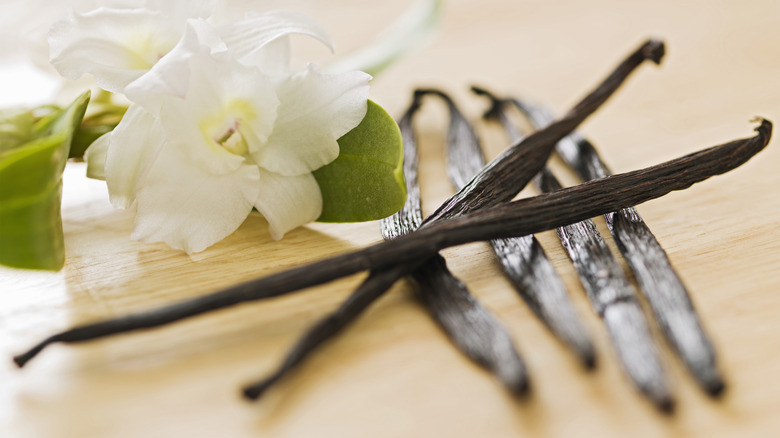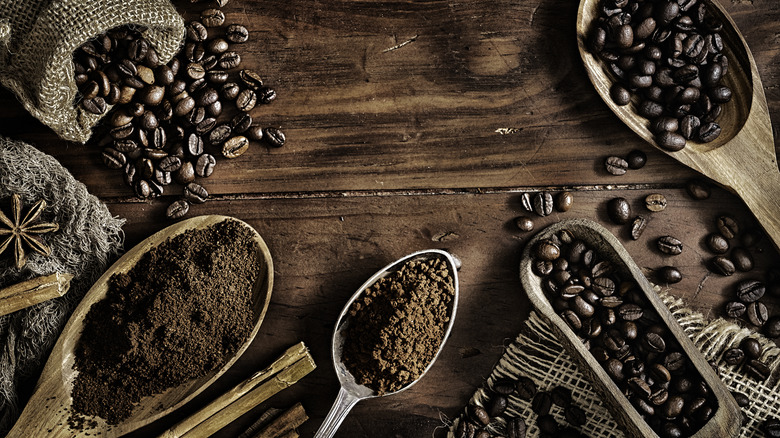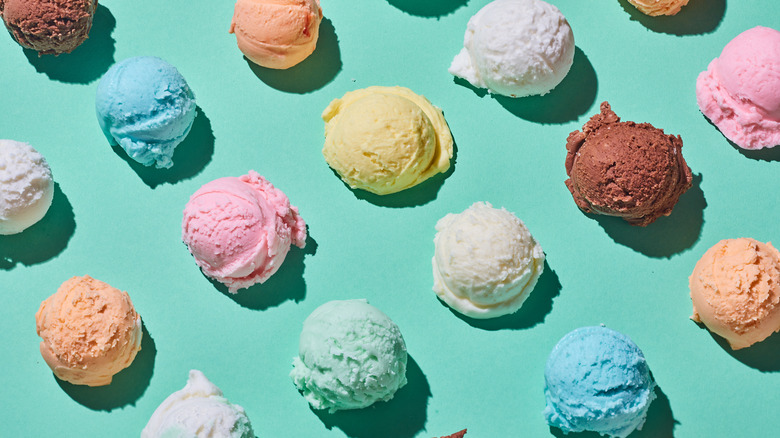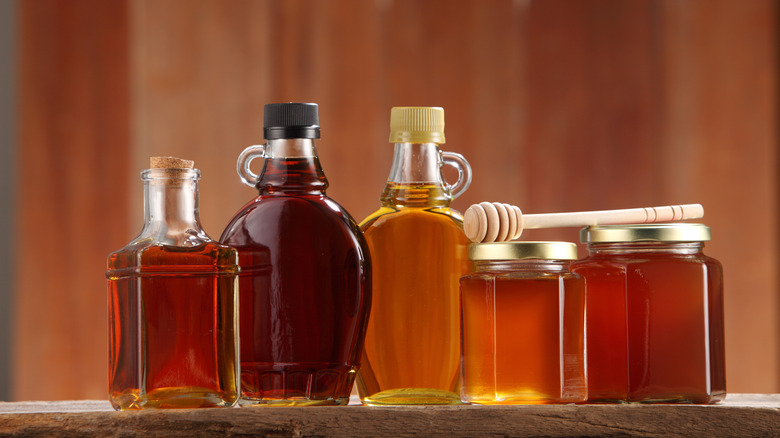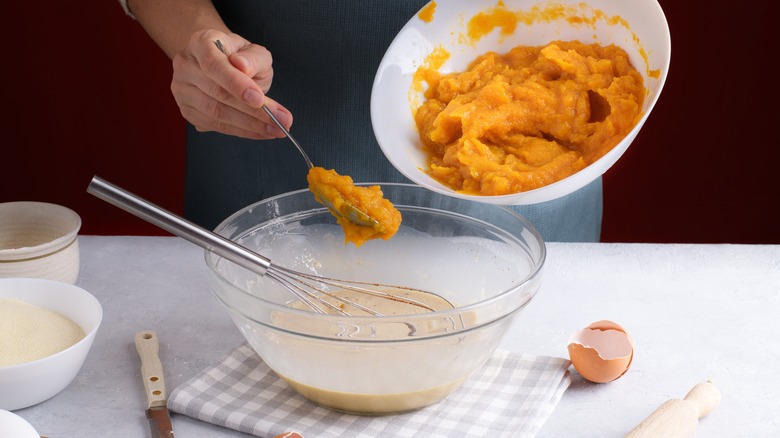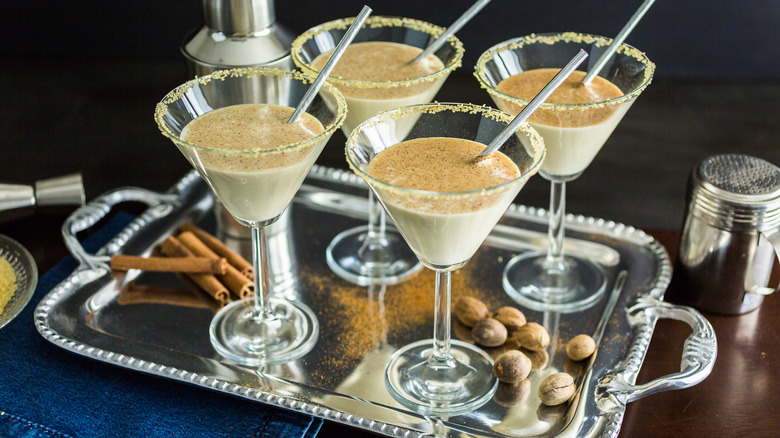10 Ways To Add Flavor To Eggnog, Without Booze
Love it or hate it, eggnog is a quintessential holiday flavor. It is decadent, rich, and creamy, which makes it the perfect treat during a season marked by celebrations and culinary delights. Ranging from soft ivory to pale yellow in color, the drink has a delicate egg flavor layered with a touch of vanilla and a generous amount of nutmeg. Then there is the booze.
Whether eggnog is store-bought or homemade, many think the drink is only complete with a generous glug of brandy, rum, bourbon, or sherry. This is understandable, as the liquor thins out the viscosity and adds sharpness to cut through the rich dairy. The good news for those who want to enjoy eggnog in their coffee bright and early on a weekday, or who choose to avoid alcohol altogether, is that there are plenty of other ways to add flavor to eggnog without adding any bottled spirits. Holiday spirit, you'll have to add yourself.
I have always been a fan of eggnog. Growing up, I didn't care that my siblings passed on it, as that meant more for me! That was always a store-bought version, and it wasn't until I started working as a recipe developer and editor that I was exposed to the various ways to prepare and flavor eggnog, making it easy to modify the base to your tastes.
How to make eggnog
Before understanding how to flavor eggnog, it's helpful to understand how it is made and what mistakes everyone makes with homemade eggnog. As the name suggests, the base of eggnog is, in fact, eggs. Traditionally, the eggs in eggnog were left raw. They were beat with sugar until thick and then mixed with milk, cream, and alcohol. Then, egg whites were whipped until stiff and folded into the base to lighten the texture. The alcohol not only added flavor to eggnog, but it has been used as a preservative to prevent the growth of bacteria, helping keep the raw egg mixture safe to drink. However, this is not a guarantee, and many people feel it is not worth the risk of possible food poisoning.
Today it's more popular to treat eggnog like a custard. The eggs are carefully combined with heated milk, cream, and sugar, and then cooked until thickened. The mixture is strained to catch small lumps of cooked egg before it's cooled. The raw whipped egg whites are now often replaced with whipped cream. The lack of raw eggs also means the drink can be refrigerated and enjoyed for several days after making it. For those wanting to try the traditional method, look for pasteurized eggs, which are safe to consume without further cooking.
Enhance eggnog with citrus
Take a hint from ponche crema, the Venezuelan eggnog with a citrus twist, and add some fresh citrus to your next batch of eggnog. Lemon, lime, and orange are all flavors that pair well with creamy things. Just think about orange and vanilla popsicles, lemon bars, or lime sherbet!
To keep the dairy from curdling, use citrus zest for flavor versus the more acidic juice. If making homemade eggnog, remove several strips of zest from your choice of citrus (choose one type or mix a few) using a vegetable peeler, and trim off any white pith from the inside of the strips, as it can add unwanted bitterness. Drop the peels into the saucepan with the dairy while heating it, and leave them in while the mixture cooks, cools, and chills so they continue to steep. Strain the eggnog or pull the peels out before serving. For prepared eggnog, finely grate a little zest directly into your cup or a large serving bowl and mix it in well. Just a pinch will do to add flavor without ending up with a mouthful of zest.
Pour in some coconut milk or coconut cream
Coquito is the Puerto Rican version of eggnog. While it doesn't usually contain eggs, it's similar to eggnog in other ways. Both drinks have a creamy milk base laced with warm spices. Coquito also contains liquefied coconut, and is often heavily doused with rum — but like eggnog, the alcohol can be left out and it's still delicious. While coconut milk or cream are non-dairy ingredients, they provide plenty of richness to keep the drink from tasting watery, and the coconut flavor offers more nuance.
You can easily merge some coquito flavors into homemade eggnog. The coconut taste in coquito often comes from sweetened cream of coconut or condensed coconut milk. If making homemade eggnog, add either of those sweetened options, while cutting back on the white sugar. You can also replace some whole milk with unsweetened coconut milk, which doesn't taste as strongly of coconut as sweetened coconut products. Coconut extract can boost the flavor if it's not strong enough.
Flavoring store-bought eggnog with liquefied coconut can be achieved in two ways. If the eggnog is thick, you can thin it with some coconut milk (but remember to always shake canned coconut milk or make sure it's well-stirred before adding). Blend or strain it if there are any small lumps of coconut cream. Coconut extract is the other, faster option. Start with only a drop or two since it is strong, and the drink's taste can quickly go from refreshingly coconutty to artificial.
Add other spices
Nutmeg is a key flavor in eggnog, and while this spice is an expected addition, there is no need to stop there. Spirits like bourbon or rum have an earthy, spicy flavor that can be imitated with a thoughtful spice blend. Cinnamon is the first spice that comes to mind, as it already has a track record of being delicious with eggnog — in fact, eggnog is the secret to make store-bought cinnamon rolls more festive. Beyond cinnamon, allspice berries, cloves, and black peppercorns are all options that would add a warming flavor and complexity.
For homemade eggnog, try adding whole allspice berries, cinnamon sticks, a few cloves, or even a few black peppercorns to the milk while it's heating to infuse the whole batch. To prevent the spices from tasting too bitter or intense, strain them out before refrigerating. You can always sprinkle some ground spices into the drink before serving to refresh the flavors, but you don't want them to overtake the more delicate nutmeg and dairy essences.
For store-bought eggnog, a sprinkle of ground spice stirred into the batch or just over each cup will add depth of flavor. Beyond single spices, consider blends like pumpkin pie spice, apple pie spice, or gingerbread spice. For a more intense flavor, try toasting whole spices and grinding them very finely before sprinkling the resulting powder into the eggnog.
Look beyond vanilla extract
In addition to the spice in eggnog, vanilla extract enhances the dairy base and gives it a well-rounded flavor. However, there are many different extracts available, and there is no need to only use vanilla. Adding another type of extract is a fast way to add a separate, unique flavor, or help replicate the flavors from a specific spirit.
Pure almond extract is an easy substitute for amaretto liqueur flavor without alcohol. Add it with a gentle touch, as it is quite strong. Moderation is key when using any extract, as they are very concentrated and a heavy hand can leave a strong, bitter flavor. Coconut extract can imitate coconut rum, while cinnamon extract has the same spicy candy flavor as cinnamon whiskey. Peppermint, while not a flavor for everyone, is a booze-free duplicate for peppermint schnapps. Rum extract is more of an outlier, tasting more buttery than the spirit, but with a light hand and some experimenting, it can also offer a tasty twist.
If adding extract to homemade eggnog, incorporate it after the egg mixture has been cooked and strained. Warming an extract takes the harsh edge off of the concentrated flavor without fully muting it. Adding it to prepared eggnog is as easy as stirring it into a glass or bowl, but since it's not getting heated, you should add much less to avoid an overly harsh taste. Dip a toothpick or chopstick into the extract to collect just a drop or two at a time.
Use vanilla beans
Vanilla extract is affordable and widely available, but to make your eggnog sing with vanilla, you need the whole bean. From cakes to cookies, vanilla beans can transform simple recipes. Vanilla is made up of the outer pod and the inner seeds. Both parts of vanilla have their own flavor, so using the pod and the seeds adds a deeper, more complex vanilla flavor.
For homemade eggnog, make sure you buy only the best vanilla beans. To split a vanilla bean, slice lengthwise down the pod and then use the back of a knife to scrape the inside to remove the seeds. Add the pod and the seeds to the pot with the milk mixture before heating. The seeds will initially look like a sticky paste, but once you add them to the milk and whisk, they will break apart into the tiny flecks you expect. You can leave the pod in the cooked eggnog until it's ready to serve, as it will continue to add flavor, but it will not emit any harsh flavors, just more intense vanilla essences.
To add this extra boost of vanilla to prepared eggnog, jarred vanilla bean paste is the easiest route. Since you aren't heating anything, the pod of a whole bean isn't useable. Vanilla bean paste is just vanilla bean seeds in a lightly sugary syrup. It is easier to blend into a cold drink than scraped vanilla seeds, but will impart the same pronounced vanilla flavor.
Add a twist with coffee or cocoa
Adding eggnog to hot espresso or coffee is a rich holiday delight. Even though Starbucks discontinued its holiday eggnog latte, you can still enjoy coffee flavor in your eggnog. Control the intensity of the coffee flavor without making watery eggnog by using instant espresso powder. If making homemade eggnog, whisk it into the milk when heating so it dissolves. This is also a good time to taste and adjust the flavor. Make the milk base a little stronger than how you want the finished eggnog to taste, as the whipped cream that gets folded in later will soften the flavor. For prepared eggnog, dissolve some espresso powder in enough warm water to make a thick paste, and stir that into your eggnog.
Chocolate pairs beautifully with warm spices and cream, and is an ideal addition to eggnog. Blending in melted chocolate would make the drink too thick and rich. Instead, choose an unsweetened cocoa powder to give a deep chocolate flavor. There are many types of cocoa powder to choose from, but Dutched, dark, or black cocoa powder would be the best choices as they are not as bitter as natural unsweetened cocoa. Similar to espresso powder, cocoa powder needs to be dissolved. Heat it with the milk for homemade eggnog, or dissolve it in warm water before stirring into prepared eggnog. Don't forget to have some chocolate shavings or curls on hand for garnish!
Melt some ice cream
One of the easiest hacks for making homemade eggnog is to skip cooking the base custard and replace it with melted vanilla ice cream. It makes perfect sense, since many vanilla ice creams have the same ingredients as eggnog: eggs, milk, cream, and sugar. Then, all you need is some nutmeg and any other flavors you choose. Adding alcohol thins the texture of the melted ice cream, which might otherwise be too thick to drink, but a little more milk can easily replace the booze.
To take your eggnog in a new direction, there is no reason to stick to using plain vanilla ice cream. While vanilla will still make a good base, you can also branch into French vanilla. Other ice cream flavors that would complement the flavor of eggnog include butter pecan, dulce de leche, or rum raisin (but check the label, as some brands may contain real rum). If any of these are made with chunky ingredients, strain them out after melting the ice cream to keep your eggnog smooth.
Use some maple or agave syrup
Bourbon, rum, and brandy all have sweet notes of caramel, so if you stay away from spirits, why not look to booze-free ingredients that can add those same flavors? Replacing some of the white sugar in eggnog with maple or agave syrup will add a complex, sweet nuance.
Both maple and agave syrups are sold in different varieties and are versatile kitchen staples. Maple syrup is sorted into grades that range from light to dark in color and flavor. Similarly, agave syrup is available in mild to robust varieties with darkening shades to match. Just like when using syrup for mixing up a cocktail, which grade or variety to use is a personal decision based on how strongly you want the syrup to flavor the eggnog.
White sugar is still needed to make the custard base in homemade eggnog, but you can cut back on the amount used when cooking the eggs and then whisk in some syrup to taste while it is still warm. Prepared eggnog is already sweet, which can make adding a syrup more challenging. Try topping a glass with freshly whipped cream sweetened with maple or agave, or rim the glass lightly with some syrup. It will add flavor while imparting a minimum of extra sweetness.
Channel the season and add pumpkin
Is there anything that can't be flavored with pumpkin? While some combinations may seem like a stretch, consider the frenzy around pumpkin spice lattes, which proves that creamy dairy and warm spices are a perfect match for earthy pumpkin. It's a great idea to swap out milk with eggnog to make tastier pumpkin pie, so why not flip the formula around and whisk some pumpkin puree into your eggnog base? Not only will it make the drink a pretty orange color, but the earthy squash flavor will cut the richness and enhance the eggnog's spices.
If making homemade eggnog, you can add pumpkin puree (not pumpkin pie filling) to the milk when heating it. This will give the base a pumpkin flavor while also cooking out any excess water from the puree. If starting with prepared eggnog, you can still use canned pumpkin puree, but wring out the extra water so that this addition only adds concentrated pumpkin flavor to your eggnog.
Rim the glass
Sweet or spiced, adding a decorative rim to a glass adds flavor with every sip, and instantly makes that drink feel special and celebratory. It is a simple thing to do with so many possibilities, and there is no need to limit this to cocktails. Margarita glasses are often rimmed with salt, a combo of salt and sugar, or a spice mixture because all of those flavors complement the tequila and the citrus in the drink. By the same logic, eggnog can benefit from several different flavors on a rim.
Since this is a sweet, creamy drink, straight salt is not the best choice. But a pinch of salt mixed into vanilla or maple sugar can help cut the sweetness and enhance the flavor. Try mixing citrus zest into sugar for a fresh burst. To moisten the rim, you can use water, a light brush of syrup, or a wedge of lemon, lime, or orange. To fully embrace a festive touch, try some finely shredded coconut to create a snowy vibe, or add a colored sugar cocktail rim to light up the room.
